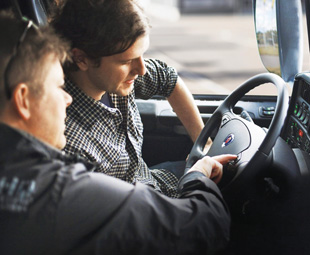Forgetting K53

Know what S.I.P.D.E. stands for? No? Well, read on to find out…
Driver training is a concept often discussed in FOCUS – after all, when millions of rand in vehicle capital and customer stock is being moved on public roads, no reputable transport company would want just anybody behind the wheel of its vehicles.
Yet, how many transport operators – or corporate companies in general – extend the concept of driver training to the rest of their staff? It has long been accepted that South Africa’s K53 driving system is out of date and leaves the country’s drivers woefully underequipped to tackle modern traffic conditions and the generally poor attitudes of the country’s drivers.
While many managers may not believe they are obliged to do so, empowering all employees when on the road can have both immediate and far-reaching benefits.
I recently attended a refresher defensive-driving course with driver-training company MasterDrive. A well-known name in driver training, MasterDrive presents a TETA-approved course consisting of internationally recognised driving standards. A two-hour theory session is followed by an hour of on-road driver evaluation.
While this is not the first time I have done such a driving course, and I have done numerous other advanced-driving courses, I do believe that this type of course is by far the most beneficial to those driving on South Africa’s roads every day. The principles apply in equal measure to newly licenced and experienced drivers…
For example, have you yet figured out what S.I.P.D.E. stands for? No?
• SCAN your surroundings for hazards, always looking 12 seconds up the road;
• IDENTIFY the hazard (of which there are three different types: moving, fixed and variable/changing);
• PREDICT what might be about to happen;
• DECIDE what course of action to take;
• EXECUTE your decided action calmly and smoothly.
Naturally, there’s a lot more to know; the S.I.P.D.E. principal is only the tip of the iceberg. In actual fact some of the points imparted in the course will already be common knowledge to many in the transport industry…
Truck drivers, for example, are required to complete comprehensive pre-trip vehicle inspections before setting off each morning. Thinking back, this is something all motorists are required to do in the yard during their K53 examination – but how many ever do so again?
As well as teaching foresight and patience, the defensive driving course reminds us of the importance of the simple tasks that could save your life, your family’s lives and the lives of other road users before the vehicle’s engine is even started.
A defensive driving course brings home numerous truths. The first is that driving a motor vehicle – any motor vehicle – is a privilege, not a right.
The second is that far too many motorists abuse that privilege, and, in the process, place themselves and other road users in very real, altogether unnecessary danger.
The third is that many drivers suffer from a poor attitude, and fail to realise the actual limitations of their driving skills, and how easily these can be improved.
I highly recommend investing in such a course. Being a safer, conscious driver translates into being a more economical driver, which saves fuel and running costs. Most importantly, it could also mean saving a life.
Published by
Focus on Transport
focusmagsa




